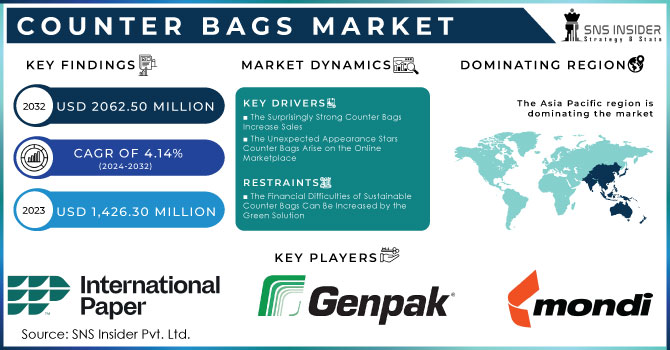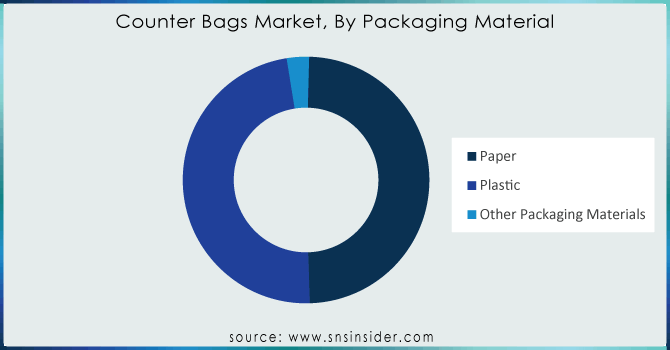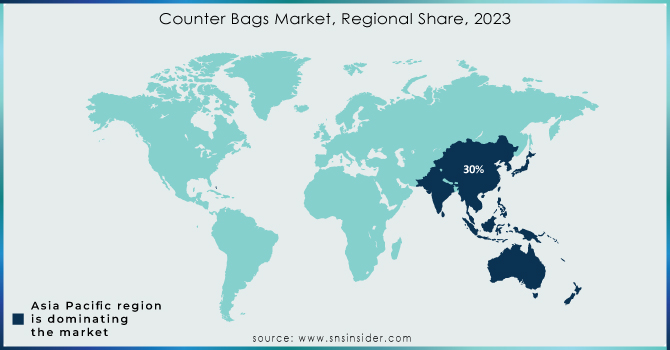Counter Bags Market Report Scope & Overview

Get More Information on Counter Bags Market - Request Sample Report
The Counter Bags Market was Valued at USD 1,426.30 Million in 2023 and is now anticipated to grow to USD 2062.50 Million by 2032, displaying a compound annual growth rate (CAGR) 4.14% of during the forecast Period 2024 - 2032.
The growing need for practical and fashionable bags in retail and business environments is fueling the growth of the counter bag industry. These thin bags also referred to as point-of-sale or checkout bags are made of different materials and are available in a range of sizes to meet a variety of requirements. They are essential in helping retailers expedite the checkout process and provide customers with a useful way to carry their products.
The market is growing because of a number of reasons. There will always be a need for counter bags due to the global retail and commercial sectors' explosive growth. Hassle-free shopping experiences are becoming more and more important to customers, and these bags offer a practical solution. Since counter bags are frequently used to package home goods, the growing e-commerce sector has further increased demand.
Sustainability is a significant factor impacting the counter bag industry. With mounting environmental concerns, both businesses and consumers are opting for eco-friendly packaging solutions. As a result of this trend, there is a high demand for counter bags made of recyclable paper and biodegradable plastic. The market for counter bags is changing; these practical necessities are becoming strategic brand extensions and silent defenders of sustainability.
Checkout or point-of-sale bags, sometimes referred to as counter bags, are no longer an afterthought. These days, they serve as a canvas for eye-catching patterns, environmentally friendly materials, and useful elements. Counter bags, which range from sturdy, reusable totes to eye-catching paper bags imprinted with personalized logos, are revolutionizing both consumer behavior and business-customer interactions.
Market Dynamics
Drivers
The Surprisingly Strong Counter Bags Increase Sales
The shopping experience is transforming, placing importance on convenience and building relationships with the brand. In this landscape, an unlikely hero emerges: the counter bag. Once a mundane afterthought, counter bags are now strategic tools. They streamline the checkout process, provide effortless carrying solutions, and eliminate post-purchase hassles - all contributing to customer satisfaction.But the power of counter bags goes beyond convenience. They transform into silent salespeople, acting as walking billboards with customizable designs and brand messaging. A well-designed bag can leave a lasting impression, enhance brand recall, and even create emotional connections with customers. This synergy between convenience and branding is the true strength of counter bags, shaping a positive customer experience and fostering brand loyalty.
The Unexpected Appearance Stars Counter Bags Arise on the Online Marketplace
The e-commerce revolution has fundamentally reshaped retail, but its impact extends beyond just online shopping carts. A surprising player has emerged in this digital realm – the humble counter bag. While their traditional purpose resided in brick-and-mortar stores, counter bags are finding exciting new applications in the world of e-commerce deliveries.
Counter bags, particularly those crafted from durable and reusable materials, are stepping up as eco-friendly packaging solutions for home deliveries. This addresses a crucial aspect of the e-commerce experience – the physical delivery of goods. Counter bags offer a secure and convenient way to transport products, ensuring items arrive safely while aligning with the sustainability expectations of today's environmentally conscious online shoppers. This shift towards sustainable packaging not only satisfies customer preferences but also helps businesses navigate the growing regulations on plastic use, making counter bags a win-win for both parties.
The impact of counter bags goes beyond just functionality. They can be powerful brand advocates, even in the digital realm. Companies can utilize custom-designed counter bags for packaging online orders, ensuring their brand identity is present upon product delivery. This creates a consistent brand experience across all touch points, from browsing online to receiving the product at home. Imagine a customer receiving their online purchase – a pair of shoes perhaps – in a stylish, reusable bag emblazoned with the company's logo and eco-friendly messaging. This not only reinforces brand recognition but also creates a positive association between the brand and sustainability. This consistency fosters stronger customer loyalty, encouraging repeat business and positive word-of-mouth recommendation
Restraints
The Financial Difficulties of Sustainable Counter Bags Can Be Increased by the Green Solution
The push for sustainability in the counter bags market presents a significant hurdle – cost. While eco-friendly options made from recycled materials or organic fibers are increasingly in demand, their production often comes at a higher price compared to traditional plastic bags. This cost difference can be a major barrier for businesses, particularly smaller retailers operating with tighter margins. These cost considerations can be particularly challenging for smaller retailers. Operating with lower profit margins, they might be less able to absorb the initial price increase of sustainable counter bags. This can create a dilemma – prioritize sustainability and potentially sacrifice short-term profits, or opt for the cheaper, less eco-friendly plastic option. The initial purchase price of sustainable counter bags can be substantially higher than their plastic counterparts. Recycled materials might require additional processing, and organic fibers like cotton or jute may have higher base costs. The durability of these sustainable bags can vary. While some may be reusable and offer a long-term cost benefit, others might require more frequent replacement, further impacting the overall budget.
The Emergence of Reusable as a Counterweight to Bags
The counter bag market faces a complex challenge in the form of inconsistent regulations. This patchwork of regulations across geographical areas creates a logistical headache for businesses operating in multiple locations. Consumers increasingly prioritize sustainability, and reusable bags offer an attractive alternative. With their extended lifespan, they can replace countless single-use counter bags, potentially leading to a decline in overall counter bag demand. Some reusable bags are designed with style and functionality in mind, blurring the line between a practical carrying solution and a fashion statement. This can incentivize consumers to invest in a few high-quality reusable bags, further reducing their reliance on counter bags. The counter bag market can adapt. by focusing on eco-friendly materials and promoting reusability, counter bags can carve out a niche within this evolving landscape. Imagine well-made paper bags with reinforced handles or stylish cloth counter bags offered as a premium option. These sustainable counter bags can cater to customers who still value the convenience of a disposable option but also seek an eco-conscious alternative.
Segment Analysis
By Application
-
Food & Beverages
-
Pharmaceuticals
-
Homecare
-
Personal Care
-
Cosmetics
-
Other Applications
The Food & Beverage (F&B) segment dominates the counter bag industry with the market share of 23%, due to its enormous volume and the extremely different needs of its players. Consider how busy restaurants require grease-resistant bags to protect delicate pastries, while supermarkets require larger, sturdier options to handle heavy grocery hauls. Counter bags are used in a wide range of food and beverage facilities, from modest cafés to contemporary restaurants, to ensure a seamless and gratifying customer experience. This category thrives on the variety of counter bags. Counter bags' capacity to accommodate to a wide range of needs, from delicate pastries to massive beverage bottles, is what makes them such an important aspect in the F&B sector. Counter bags come in a variety of sizes, materials, and styles, allowing F&B firms to discover the ideal fit for their specific services, resulting in satisfied consumers and a successful food and beverage industry. Sponge counter bags provide a unique and potentially advantageous option. Their soft, absorbent substance is great for protecting delicate pastries, bakery products, and fresh fruits. This can help to avoid damage during shipment, reduce food waste, and provide a great client experience.
By Packaging Material
-
Paper
-
Plastic
-
Other Packaging Materials
Paper dominates the counter bag market because of its eco-friendliness, which is particularly relevant as environmental concerns gain traction. Recycled paper bags further lessen their impact on the environment, and it's a sustainable resource. Both businesses and consumers find this to be meaningful. Paper is incredibly versatile and goes beyond sustainability. Paper is available in a variety of sizes and thicknesses to meet every requirement, from delicate pastry bags to robust shopping sacks. Paper can be more affordable, especially for applications that are meant to be used just once. Its low cost makes it an economical option for companies, thus establishing its authority in the counter bag industry.

Need any customization research on Counter Bags Market - Enquiry Now
Regional Coverage
North America
-
US
-
Canada
-
Mexico
Europe
-
Eastern Europe
-
Poland
-
Romania
-
Hungary
-
Turkey
-
Rest of Eastern Europe
-
-
Western Europe
-
Germany
-
France
-
UK
-
Italy
-
Spain
-
Netherlands
-
Switzerland
-
Austria
-
Rest of Western Europe
-
Asia Pacific
-
China
-
India
-
Japan
-
South Korea
-
Vietnam
-
Singapore
-
Australia
-
Rest of Asia Pacific
Middle East & Africa
-
Middle East
-
UAE
-
Egypt
-
Saudi Arabia
-
Qatar
-
Rest of the Middle East
-
-
Africa
-
Nigeria
-
South Africa
-
Rest of Africa
-
Latin America
-
Brazil
-
Argentina
-
Colombia
-
Rest of Latin America
Regional Analysis
The counter bags Market is dominated by the Asia Pacific region is estimated to 30%. This means that plastic bags, which are frequently thought to be the most affordable option, continue to rule a price-sensitive market. A strong countermovement known as the increasing environmental consciousness movement is taking shape. More sustainable alternatives are growing in popularity as a result of consumers' and businesses' growing awareness of plastic's negative environmental effects. Paper bags are becoming more popular since they are an easily accessible and recyclable alternative. Biodegradable plastics are beginning to gain popularity, appealing to consumers looking for a sustainable and affordable solution. The development in environmental consciousness and the possibility of stronger government limits on plastic use in the Asia Pacific area are anticipated to be the primary drivers affecting a future move away from standard plastic counter bags and towards more sustainable alternatives.
The counter bag market in North America is indicative of a worldwide trend, where paper is dominant. Paper bags have remained the most popular option due to consumers' increasing attention to sustainability and their natural adaptability. From bakery bags to grocery sacks, paper is available in a variety of sizes and thicknesses to meet the needs of a broad spectrum of industries. Paper is the preferred option for numerous organizations due to its versatility and environmentally beneficial properties as a recyclable and renewable material. Enticing to both businesses and ecologically conscious consumers, these bags provide a durable substitute for single-use ones. Despite the fact that paper is still the most popular material, the reusable section of the North American counter bag industry is expected to increase at a rapid pace.
In the counter bag market, Europe follows a distinct beat. Environmental concern reigns supreme, and rules follow suit. Stringent laws aimed at reducing plastic consumption have allowed paper to become the dominant player. They are made from renewable resources and can be recycled, reducing environmental effect. This connects strongly with both European consumers and businesses, resulting in a market driven by sustainability. But the story does not stop there. Europe's environmentally aware mindset extends beyond paper. There is a growing prevalence of reusable cloth bags, especially in countries where protecting the environment is a key priority.
The counter bag landscape in Latin America, the Middle East, and Africa is divided into two areas, each driven by a complicated interaction of cost and environmental considerations. Plastic bags currently have a competitive advantage due to their low cost. This is particularly relevant in developing economies, where cost is a top priority for both firms and consumers. The tide is beginning to turn. Governments in these regions are increasingly enacting restrictions to reduce plastic use, acknowledging the environmental damage it can do. This paves the path for a transition to more sustainable solutions such as paper bags and, eventually, reusable fabric equivalents.

Key Players
Some of the major Players International Paper Company ,Novolex Holdings, LLC ,Mondi Group ,Genpak, LLC ,WestRock Company ,Berry Global, Inc. ,Smurfit Kappa Group ,Firstpack Corporation Sdn. Bhd. ,The Kroger Co. ,Wenzhou Chuangjia Packaging Co., Ltd.,Brown &Co., Sirane Ltd.
Recent Development
-
Launched in June 2022, this range offers SPOUTED pouches made from mono-material recyclable plastic. The entire RePEat range, including stand-up pouches and films, uses pure PE, allowing them to be recycled in the LDPE recycling stream. This caters to businesses seeking a more eco-friendly plastic packaging solution.
-
Big Brown Paper Bags offers a comprehensive selection of high-quality and practical paper counter bags designed with both functionality and sustainability in mind. All their paper bags, including popular options like sulfite bags, are carefully chosen for their recyclability, making them an eco-friendly choice for businesses.
| Report Attributes | Details |
|---|---|
| Market Size in 2023 | US$ 1,426.30 Million |
| Market Size by 2031 | US$ 2062.50 Million |
| CAGR | CAGR of 4.14 % From 2024 to 2032 |
| Base Year | 2023 |
| Forecast Period | 2024-2031 |
| Historical Data | 2020-2022 |
| Report Scope & Coverage | Market Size, Segments Analysis, Competitive Landscape, Regional Analysis, DROC & SWOT Analysis, Forecast Outlook |
| Key Segments | • by Application (Food & Beverages, Pharmaceuticals, Homecare, Personal Care, Cosmetics, Other Applications), • by Packaging Material (Paper, Plastic, Other Packaging Materials) • by Manufacturing (Make-to-Order Manufacturing, Make-to-Stock Manufacturing) |
| Regional Analysis/Coverage | North America (US, Canada, Mexico), Europe (Eastern Europe [Poland, Romania, Hungary, Turkey, Rest of Eastern Europe] Western Europe] Germany, France, UK, Italy, Spain, Netherlands, Switzerland, Austria, Rest of Western Europe]), Asia Pacific (China, India, Japan, South Korea, Vietnam, Singapore, Australia, Rest of Asia Pacific), Middle East & Africa (Middle East [UAE, Egypt, Saudi Arabia, Qatar, Rest of Middle East], Africa [Nigeria, South Africa, Rest of Africa], Latin America (Brazil, Argentina, Colombia, Rest of Latin America) |
| Company Profiles | International Paper Company ,Novolex Holdings, LLC ,Mondi Group ,Genpak, LLC ,WestRock Company ,Berry Global, Inc. ,Smurfit Kappa Group ,Firstpack Corporation Sdn. Bhd. ,The Kroger Co. ,Wenzhou Chuangjia Packaging Co., Ltd.,Brown &Co., Sirane Ltd. |
| Key Drivers | • The Surprisingly Strong Counter Bags Increase Sales • The Unexpected Appearance Stars Counter Bags Arise on the Online Marketplace |
| RESTRAINTS | • The Financial Difficulties of Sustainable Counter Bags Can Be Increased by the Green Solution • The Emergence of Reusable as a Counterweight to Bags |

